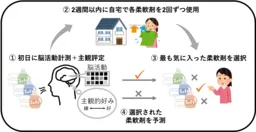

Discovering Brain Activity Related to Latent Preferences for Scents: A New Era in Product Development
Unveiling the Hidden Preferences for Scents
In a remarkable study conducted by scientists from the National Institute of Information and Communications Technology (NICT) and Lion Corporation, innovative methods have been developed to understand how latent preferences for scents manifest in brain activity. Led by researchers T. Okumura and I. Kida, this research marks a shift from subjective assessments to more objective measures in product development, particularly in scented products.
The Study's Findings
This research highlights the brain's ability to provide insights that go beyond conscious subjective evaluations. During their experiments, researchers analyzed the brain activity of 25 female participants as they encountered three novel scents of fabric softeners they had never previously used. Utilizing functional Magnetic Resonance Imaging (fMRI), the researchers observed brain activity in response to these scents while recording participants' subjective preferences.
Interestingly, predictions based solely on subjective evaluations yielded an accuracy rate of about 50%, which is comparable to random guessing. In stark contrast, the participants' brain activity—especially in areas associated with reward processing and olfactory information—resulted in a significantly higher prediction accuracy of around 60%. This indicates that even initial encounters with an unfamiliar scent elicit latent preferences that manifest in our brain's responses, which are not necessarily reflected in conscious evaluations.
The Importance of Objective Indicators
Understanding these hidden preferences is vital for the future of product development. The results suggest that relying on simply consumer feedback might not provide the most reliable indicators for their true preferences. Instead, integrating insights from brain activity can lead to the creation of more effective and appealing products. As society increasingly prioritizes personalized experiences, leveraging brain data could transform how brands approach fragrance and other sensory products.
Previous Research and Context
Prior studies have indicated that brain activity can reveal latent information about consumer preferences beyond self-reported measures. Research on product images and music signals has shown that the brain can predict choices based on neural responses, paving the way for the current study's innovative techniques. This research builds on those principles, indicating that similar strategies can be applied to the realm of scents and fragrances.
Methodology and Analysis
During the study, participants were asked to smell the three scents and indicate their immediate likes or dislikes. Following this initial assessment, they used the scents in their homes over two weeks, subsequently choosing the softener they preferred most. While their subjective evaluations failed to predict user preferences reliably, brain analysis yielded more substantial insights due to its focus on neural responses relating to reward systems and olfactory processing areas.
Interestingly, this study also diverges from traditional methods. Instead of creating individual predictive models, the researchers pooled brain activity data from all 25 participants. This collective model allowed for predictions that account for general trends while minimizing the impact of individual variability, moving toward creating universally applicable models rather than those relying solely on individual characteristics.
Future Implications
The implications of this research are profound. Not only does it advance our understanding of how latent preferences for scents are processed in the brain, but it also sets the stage for more reliable and objective measures of scent evaluation in product development. As researchers work to enhance prediction accuracy, there is potential for a paradigm shift in developing scented products tailored to individual preferences based on brain activity. This could forever change the landscape of consumer product innovation, where scents become as personalized as skin care or fashion choices.
Conclusion
In essence, this pioneering research not only delves into the neural mechanisms behind our preferences for scents but also presents exciting opportunities for more targeted and successful product development in the fragrance industry. By transcending traditional subjective metrics, brands can hone their fragrance offerings to resonate more closely with actual consumer desires, paving the way for a new generation of scent-based products.
References
- - Okumura, T., Saito, K., Harada, R., Ohki, T., Hanihara, H., Kida, I. (2025). Latent Preference Representation in the Human Brain for Scented Products: Effects of Novelty and Familiarity. NeuroImage. https://doi.org/10.1016/j.neuroimage.2025.121131

Topics Consumer Technology)










【About Using Articles】
You can freely use the title and article content by linking to the page where the article is posted.
※ Images cannot be used.
【About Links】
Links are free to use.